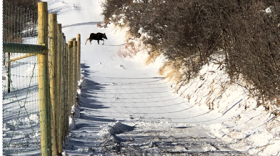The Division of Wildlife Resources has decided to relocate a young bear that’s been marauding in Summit Park for the last week. KPCW has some details on the sightings and the next steps to transport the animal away from humans.
Karen Madigen is a resident of Summit Park and she’s captured video of several night-time visits onto her property. Her ring camera shows the bear walking the perimeter of her home.
“It circled my house four times last night. We don’t even have anything, our cans were in. We have a dog and a cat, but we don’t even have a bird feeder. We have nothing out there.”
20-year Summit Park Resident, David Stice contacted KPCW to remind residents that garbage cans left outside overnight will attract bears. He says he isn’t worried about the garbage being strewn around the driveway.
“You know, bears have always lived here. I’ve lived here since ’91. And, you know they’ve always been around. But this is the first time I’ve had an issue with him knocking down the garbage every night. So, I don’t want the bear to get habituated to the food. I was watching it last night. I was in arm’s length of it, last night. I was in my living room.”
Stice says he’ll move his bees because the bear broke through his electric fence and swatted at the hives. The neighborhood social pages have been lit up with stories and Stice says he has spent time on his street stopping traffic requesting neighbors keep their cans inside, clean their bar b que grills and put bird feeders away.
Since the bear seems to be settling into the neighborhood, Stice and others contacted the DWR asking them to trap and relocate the animal.
Scott Root, Conservation Outreach Manager with the Division of Wildlife Resources explains how the live trap works to safely pen the bear. They usually tranquilize the animal before transporting it several miles away from the site.
“We also refer to them as culvert traps. They’re kind of circular around, pipe like but a large culvert. The end of it, we have like a little bag full of all types of fun treats that bears like. The other end is open and it has a door that will slide shut. So, they don’t get hurt.”
It’s impossible to be scent free so when cooking outside, be sure the clean up is very thorough. Root doesn’t want people to be afraid of bears and asks the public to call the DWR if one is hanging out in your yard.
“People that are cooking freshly caught fish up in the High Uintah’s or whatever. I mean, there’s going to be smell there. The best thing to do is when you’re done with that meal, clean up very well and keep everything in the trunk of the vehicle if at all possible. If you’re in the back country, put it in a canvas bag and hoist it up, quite a ways up the tree with a rope.”
Root says it can take from a few minutes to a few days to trap a bear.
“I’ve actually been setting up a live culvert trap and had the bear walk right through it and we started throwing food into the culvert trap right there from the back of the pick-up truck.”
Karen Madigen’s video of the bear can be found on KPCW.org
https://www.youtube.com/watch?v=p9Iu7PtLMdo







